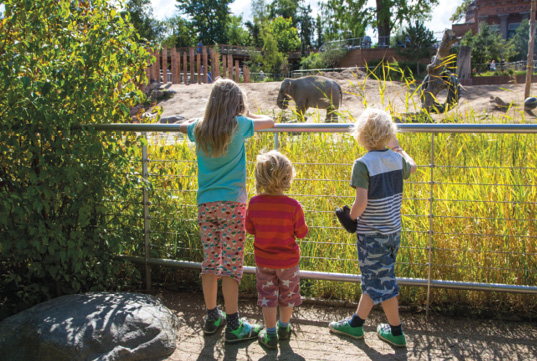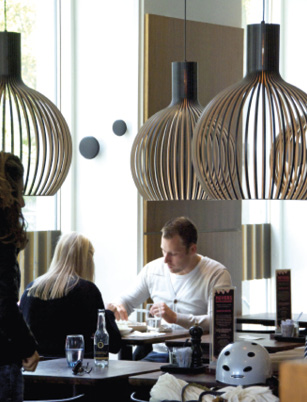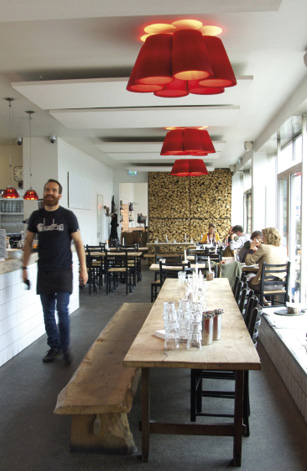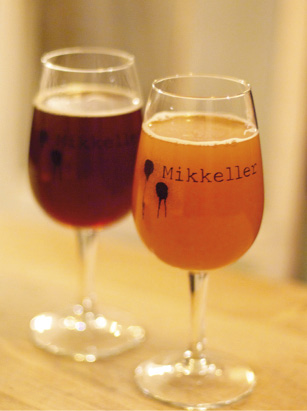Vesterbro and Frederiksberg
Shops
Cafés and restaurants
Bars
Music venue
The two neighbouring districts of Vesterbro and Frederiksberg couldn’t be more contrasting. Vesterbro was until recently a neglected working-class area. Urban regeneration projects over the past fifteen years have smartened it up, inflating the value of property, and attracting more affluent residents. They have also brought with them a slew of edgy art galleries, restaurants and bars such as those in the über-trendy, newly converted Kødbyen meat-packing area. Conservative Frederiksberg combines elegant tree-lined avenues, beautiful parks and grand villas – a stroll down Frederiksberg Allé to the romantic seventeenth-century Frederiksberg Have (gardens) and palace gives a flavour of its well-heeled opulence. The quaint little street of Værnedamsvej links the two districts with some superb places to eat and drink, exclusive shops and a neighbourly, outgoing feel.
Vesterbrogade and Istedgade
map
As one of the main arteries leading into the city, Vesterbrogade has been lined with restaurants and inns since the sixteenth century. Today, it offers access to the hugely popular nightlife of Kødbyen, and retains a bohemian atmosphere thanks to the large number of artists and musicians who still live here. Running roughly parallel, Istedgade is all that is left of the city’s once infamous red-light district which flourished after the legalization of pornography in the 1960s. Today a handful of hookers and the occasional porn shop near Central Station is all that remains.
Værnedamsvej
Musikmuseet
map
Rosenørns Alle 22  41 20 63 13,
41 20 63 13,  natmus.dk/museerne/musikmuseet. Tues–Sun 10am–5pm. 50kr.
natmus.dk/museerne/musikmuseet. Tues–Sun 10am–5pm. 50kr.
After years in storage, the many bizarre exhibits of the Danish museum of music have finally re-emerged in the highly appropriate setting of Danmarks Radio’s former headquarters, a modernist building designed by acclaimed architect Vilhelm Lauritzen in 1954, close to the Forum exhibition hall and metro station.The many instruments on display, which include an amoeba-shaped violin and a giraffe piano, come from all four corners of the globe and date back as far as the 1500s. There is also the “klingende museum”, a specially soundproofed room where children and young people can try out instruments and play to their hearts’ content without disturbing the neighbours.
Tycho Brahe Planetarium
map
Gammel Kongevej 10  33 12 12 24,
33 12 12 24,  planetariet.dk. Mon noon–7.40pm, Tues–Thurs & Sun 9.30am–7.30pm, Fri & Sat 10.30am–8.45pm. Adults/children under 12 150kr/99kr including IMAX film, 89kr/64kr without.
planetariet.dk. Mon noon–7.40pm, Tues–Thurs & Sun 9.30am–7.30pm, Fri & Sat 10.30am–8.45pm. Adults/children under 12 150kr/99kr including IMAX film, 89kr/64kr without.
Housed in a massive and unmissable yellow-brick cylinder at the foot of Sankt Jørgens lake, the city’s planetarium is named after sixteenth-century Danish astronomer Tycho Brahe. There’s a large interactive exhibition on offer, but for many visitors – especially the local schoolkids who overrun the place during the week – the main attraction is the enormous 3D IMAX screen in the planetarium’s central Space Theatre, which shows science and nature films.
Kødbyen
map
Once Copenhagen’s former meat-packing district, Kødbyen is now one of the trendiest areas in the city. It encompasses cutting-edge galleries and arty cocktail bars, rustic-chic restaurants and grungy nightclubs, with a vibe that changes through the day. Until noon the feel is cold industrial, with life emanating only from the few remaining food-processing plants. After lunch, the galleries begin to open and a colourful, trendsetting crowd moves in. Come evening the restaurants pack out with diners and then partygoers who continue the evening milling from bar to bar, and later on into the nightclubs.
Kødbyen’s earliest buildings – the eastern, “brown” part of the site – date back to the late nineteenth century when the city’s slaughterhouses were focused on one site in a bid to improve hygiene. The original indoor cattle market has now been converted into the Øksnehallen exhibition centre, an interesting building with a vast vaulted ceiling that hosts regular photography exhibitions as well as trade fairs for food and fashion, most of them open to the public. In the 1930s the district was extended with the so-called “white” section to the west, whose functionalist blue-and-white-tile-covered buildings are now protected as an industrial monument.
Tycho Brahe Planetarium
Carlsberg Visitor Centre
map
Gamle Carlsbergvej 11  33 27 12 82,
33 27 12 82,  visitcarlsberg.dk. Daily 10am–5pm. 85kr.
visitcarlsberg.dk. Daily 10am–5pm. 85kr.
Carlsberg’s slick visitor centre takes you through the history of the brewery and provides an insight into the interlinked history of Danes and beer. Highlights include the iconic Elephant Gate, the world’s largest collection of beer bottles (over 20,000) and a wonderful assortment of old advertising campaigns.
Although it lacks the noise and excitement of a large working brewery, you do get the opportunity to sample (alongside regular Carlsberg) some interesting beers from the on-site microbrewery, the Jacobsen Brewhouse, at the end of your visit.
The Carlsberg quarter
Exciting developments are well under way on the site of the old Carlsberg Brewery, which moved its production to a new, modern complex in Jutland in 2006. After lengthy public consultation it was decided to develop the site into a vibrant new cultural and residential quarter, Carlsberg Byen.
The project is still ongoing, but a number of galleries and cultural institutions have already moved in, such as Dansehallerne ( dansehallerne.dk), a modern-dance performance venue at Tap E (scheduled to move out 2016) and, in the old garages, Galleri Nicolai Wallner (
dansehallerne.dk), a modern-dance performance venue at Tap E (scheduled to move out 2016) and, in the old garages, Galleri Nicolai Wallner ( nicolaiwallner.com), the city’s largest private gallery for contemporary art. You could easily spend a half-day exploring the complex. Landmark sights include the iconic Elephant Gate, the glorious winding Lotus Chimney, the Lime Tower lighthouse and the Star Gate – the original main entrance to the brewery. Many of Carlsberg’s luscious green spaces have also been opened up to the public, including J.C. Jacobsen’s delightfully tranquil garden, which was first laid out in 1848.
nicolaiwallner.com), the city’s largest private gallery for contemporary art. You could easily spend a half-day exploring the complex. Landmark sights include the iconic Elephant Gate, the glorious winding Lotus Chimney, the Lime Tower lighthouse and the Star Gate – the original main entrance to the brewery. Many of Carlsberg’s luscious green spaces have also been opened up to the public, including J.C. Jacobsen’s delightfully tranquil garden, which was first laid out in 1848.
Frederiksberg Have and Slot
map
Roskildevej  ses.dk. Gardens: 6am–sunset; free. Palace: guided tours Jan–June & Aug–Nov last Sat of the month 11am & 1pm; 50kr.
ses.dk. Gardens: 6am–sunset; free. Palace: guided tours Jan–June & Aug–Nov last Sat of the month 11am & 1pm; 50kr.
One of the city’s most beautiful and romantic spots, Frederiksberg Have was originally laid out in the late seventeenth century as gardens for the recently completed royal palace. The gardens’ Baroque formality was remodelled in the English landscape style a century later, with winding paths weaving across undulating lawns, boating canals and numerous follies hidden among the trees. The park can be accessed from all sides, but arriving from the slot gives you the best overview of its layout. Hugely popular for picnicking and lounging, the gardens also host music and theatre performances in summer (check the website for details).
Frederiksberg Slot itself, built in Baroque style, was the royal family’s main summer residence until the mid-1800s, and now houses the Danish Officers Academy – it’s therefore off-limits except for the infrequent guided tours. The interior is awash with intricate stuccowork and bold and colourful ceiling paintings; grandest of all is the elaborately decorated chapel, which you may find a little over the top.
Zoologisk Have
map
Roskildevej 32  72 20 02 00,
72 20 02 00,  zoo.dk. Open from 10am; closing times vary (check website). 180kr, children under 12 100kr.
zoo.dk. Open from 10am; closing times vary (check website). 180kr, children under 12 100kr.
Founded in 1859, Copenhagen’s zoological gardens encompass everything you’d expect from a zoo with over 3000 caged animals from around the globe. Aside from the wooden 44m observation tower (1905), two recently added structures stand out: Foster & Partners’ etched-glass-domed Elephant House, complete with underfloor heating, and Danish architects Dall & Lindhardsen’s Hippo House, where you can watch the animals frolic underwater. Both are easily visible from neighbouring parks (Frederiksberg Have for the elephants and Søndermarken for the hippos), so – should you wish – you can avoid forking out the entrance fee to view them.
Zoologisk Have
< Back to Vesterbro and Frederiksberg
Shops
Designer Zoo
map
Vesterbrogade 137  33 24 94 93,
33 24 94 93,  dzoo.dk. Mon–Thurs 10am–6pm, Fri 10am–7pm, Sat 10am–3pm.
dzoo.dk. Mon–Thurs 10am–6pm, Fri 10am–7pm, Sat 10am–3pm.
Welcoming store run by eight designers selling own-made furniture, jewellery, knitwear, pottery and glass. A great place for that elusive Christmas gift.
Donn Ya Doll
map
Istedgade 55  33 22 66 35,
33 22 66 35,  donnyadoll.dk. Mon–Fri 11am–4pm, Sat 10am–3pm.
donnyadoll.dk. Mon–Fri 11am–4pm, Sat 10am–3pm.
This chaotic clothes shop sells sustainably produced clothes, from bamboo underwear to soya shirts including items made by top Danish designers such as Stig P and Eco Nord.
Meyers Deli
map
Gammel Kongevej 107  33 25 45 95,
33 25 45 95,  meyersmad.dk. Daily 9am–9pm.
meyersmad.dk. Daily 9am–9pm.
Claus Meyer, founding father of the New Nordic kitchen manifesto, runs organic bakeries, farms, restaurants and these popular delis. Find his own sourdoughs, smoked ham, house pâtés, and fresh-pressed juice.
Samsøe og Samsøe
map
Værnedamsvej 12  35 28 51 02,
35 28 51 02,  samsoe.com. Mon–Thurs 10am–6pm, Fri 10am–7pm, Sat 10am–4pm.
samsoe.com. Mon–Thurs 10am–6pm, Fri 10am–7pm, Sat 10am–4pm.
Cool own-brand designer wear for men and women, plus a few items from other labels. They’re known for their simple, loose-fitting style and punchy colours.
Summerbird
map
Værnedamsvej 9  33 25 25 50,
33 25 25 50,  summerbird.dk. Mon–Fri 11am–6pm, Sat 10am–3pm.
summerbird.dk. Mon–Fri 11am–6pm, Sat 10am–3pm.
Dinky little chocolatier selling arguably the world’s best chocolate. Try the otherworldly flødeboller (cream buns) – fluffy, chocolate-coated marshmallow treats.
Cafés and restaurants
Anarki
map
Vodroffsvej 47  22 13 11 34 ,
22 13 11 34 ,  restaurant-anarki.dk. Tues–Sun 5.30–10pm.
restaurant-anarki.dk. Tues–Sun 5.30–10pm.
As the name implies, anarchy rules in this bistro’s kitchen. Chef Rune Sauer Sonnichsen draws inspiration from all corners of the world. A multi-page global wine list attracts oenophiles. The retro kitsch decor, such as vintage maps and low lit green lamps, creates an intimate mood.
Bento
map
Helgolandsgade 16  88 71 46 46,
88 71 46 46,  uki.dk. Tues–Sat 11am–2pm, 5–10pm.
uki.dk. Tues–Sat 11am–2pm, 5–10pm.
Family-run Japanese eatery with a traditional minimalist interior. Famous for its makunouchi (bento) boxes – from 200kr – it also excels in less pricey sushi and maki rolls, and has a well-stocked Japanese cocktail bar. Takeaway available.
Café Viggo
map
Værnedamsvej 15  33 31 18 21,
33 31 18 21,  cafeviggo.com. Mon–Wed 10am–midnight, Thurs 10am–1am, Fri 10am–2am, Sat 11am–2am.
cafeviggo.com. Mon–Wed 10am–midnight, Thurs 10am–1am, Fri 10am–2am, Sat 11am–2am.
Named after the Belgian comic-book character Gaston (Vakse Viggo in Danish), this French-style café-bistro is packed both day and night. Apart from good, solid bistro dishes such as quiche forestière or steak haché, the chef excels in genuine Breton galettes.
Cofoco
map
Abel Cathrines Gade 7  33 13 60 60,
33 13 60 60,  cofoco.dk. Daily 5.30pm–midnight.
cofoco.dk. Daily 5.30pm–midnight.
Bright and modern, Cofoco sources much of its food from the Baltic island of Bornholm – where the growing season is longer and produce consequently tastier. Dishes are superb but small (75–85kr), the idea being that you sample a range.
Famo
map
Saxogade 3  33 23 22 50,
33 23 22 50,  famo.dk. Daily 6pm–midnight.
famo.dk. Daily 6pm–midnight.
Small, cheerful, no-frills Italian restaurant serving a four-course menu (370kr), prepared by a pair of Michelin-starred chefs who have decided to go it alone. Flavour-packed delicacies might include panzanella (Florentine bread-and-tomato salad, crammed with anchovies and herbs) and ribolita (Tuscan bean soup).
Frk. Barners Kælder
map
Helgolandsgade 8  33 33 05 33,
33 33 05 33,  frkbarners.dk. Daily noon–4pm & 5.30–11pm.
frkbarners.dk. Daily noon–4pm & 5.30–11pm.
With outdoor seating on a streetside terrace and a cosy cavern-like atmosphere inside, this traditional restaurant – complete with red-and-white-check tablecloths – serves time-honoured Danish classics such as herring platters (98kr) at lunch, and hakkebøf (Danish burger) with potatoes, cucumber salad and fried egg (154kr) at dinnertime.
Granola
map
Værnedamsvej 5  31 31 15 36,
31 31 15 36,  granola.dk. Mon–Fri 7am–10pm, Sat 9am–10pm, Sun 9am–3.30pm.
granola.dk. Mon–Fri 7am–10pm, Sat 9am–10pm, Sun 9am–3.30pm.
Retro-style milkshake bar whose decor – including genuine 1930s ceiling lamps from the Rover factory – shows staggering attention to detail. Breakfast (90–165kr, depending on size), smoothies and juices are served from early morning, while later on the menu centres on well-prepared home-made dishes such as quiches, salads, sandwiches – not forgetting the seriously delicious milkshakes.
Hansens Gamle Familiehave
map
Pile Alle 10  36 30 92 57,
36 30 92 57,  hansenshave.dk. Hours vary, but generally: Jan–April Mon–Sat 11am–11pm/midnight, Sun 11am–6pm; May–Dec daily 11am–11pm/midnight.
hansenshave.dk. Hours vary, but generally: Jan–April Mon–Sat 11am–11pm/midnight, Sun 11am–6pm; May–Dec daily 11am–11pm/midnight.
In a pretty garden (with a retractable winter roof) around the corner from Frederiksberg Slot this popular place excels in smørrebrød (herring 59kr). There’s also a good range of traditional hot dishes such as fried eel with parsley sauce (239kr), and roast pork with pickled red cabbage.
Kødbyens Fiskebar
map
Flæsketorvet 100  32 15 56 56,
32 15 56 56,  fiskebaren.dk. Mon–Thurs 5.30pm–midnight, Fri until 2am, Sat noon–4pm & 5.30pm–2am, Sun noon–4pm & 5.30–11pm.
fiskebaren.dk. Mon–Thurs 5.30pm–midnight, Fri until 2am, Sat noon–4pm & 5.30pm–2am, Sun noon–4pm & 5.30–11pm.
This super-trendy fish restaurant in hip Kødbyen offers sustainably sourced fresh fish and seafood, from oysters (costing from 95kr for three) to Greenland snowcrab (165kr), the menu varying according to the season and catch. With whitewashed walls and shiny black floors, it’s also a monument to cool industrial chic.
Lê Lê Nhà Hang
map
Vesterbrogade 40  33 31 31 25,
33 31 31 25,  lele.dk. Mon–Thurs 5–10pm, Fri & Sat 5–10.30pm.
lele.dk. Mon–Thurs 5–10pm, Fri & Sat 5–10.30pm.
This spacious Vietnamese place serves gorgeous dishes which you can watch being lovingly prepared in the large open kitchen. Try for instance the Saigonese papaya salad with beef and Vietnamese mint (85kr). Takeaway is available further along the street at no. 56 (daily 11.30am–9.30pm).
Madklubben
map
Vesterbrogade 62  38 41 41 43,
38 41 41 43,  madklubben.dk. Daily 5.30pm–midnight.
madklubben.dk. Daily 5.30pm–midnight.
Simple, well-prepared dishes in a funky, slightly space-age-styled restaurant (part of a small chain) right on the main drag of Vesterbrogade. The straightforward concept (choose from one to four courses, 100–250kr) is a big hit with the Vesterbro crowd. Favourite mains include the fish of the day and the truffle-oil risotto (both cost 100kr).
Mother
map
Høkerboderne 9  22 27 58 98,
22 27 58 98,  mother.dk. Mon–Sat 11am–1am, Sun 11am–11pm.
mother.dk. Mon–Sat 11am–1am, Sun 11am–11pm.
Organic sourdough pizza served in a long, rustic butcher’s hall in industrial-hip Kødbyen. Mother’s chipper Italian proprietor, who also mans the door, is kept busy throughout the day as hungry diners arrive in droves. Pizzas start at 75kr for a filling Marinara. There is a small but select wine list as well as full-flavoured Menabrea beer on draught.
Paté Paté
map
Slagterboderne 1  39 69 55 57,
39 69 55 57,  patepate.dk. Mon–Wed 9am–midnight, Thurs 9am–1am, Fri 9am–3am, Sat 11am–3am.
patepate.dk. Mon–Wed 9am–midnight, Thurs 9am–1am, Fri 9am–3am, Sat 11am–3am.
On-trend Kødbyen wine bar-cum-restaurant housed in a former meat pâté factory. Apart from a vast selection of great wines, Paté Paté also offers good, solid French food, with lighter bites on offer at lunchtime and dinner mains, which include onglet steak (185kr) and duck confit (190kr).
Pony
map
Vesterbrogade 135  33 22 10 00,
33 22 10 00,  ponykbh.dk. Tues–Sun 5.30pm–noon.
ponykbh.dk. Tues–Sun 5.30pm–noon.
This simple, cosy bistro serves artfully prepared courses made from Danish inputs without fuss, muss, foam, or small plates. Two-course meals are 325kr, three are 425kr, but it’s probably worth making the small leap to 485kr for the four-course offering. The excellent wine list favours small producers of organic wines.
Riccos Kaffebar
map
Istedgade 119  riccos.dk. Mon–Fri 8am–11pm, Sat & Sun 9am–11pm.
riccos.dk. Mon–Fri 8am–11pm, Sat & Sun 9am–11pm.
Riccos coffee shops have spread throughout the city but this is where it all started, and their unfaltering passion for good organic coffee is still in evidence. Packed into a tight space with only a few tiny tables and a long communal bench along the wall, coffee aficionados cram together here every morning for their caffeine fix.
Spuntino
map
Vesterbrogade 68  70 20 50 89,
70 20 50 89,  cofoco.dk. Mon–Sat 5.30pm–midnight.
cofoco.dk. Mon–Sat 5.30pm–midnight.
Part of the excellent Cofoco chain, no-frills Spuntino offers Italian classics such as arancini, braised lamb shank and panna cotta. Mix and match as you wish (65–100kr/dish) or go for the recommended five-course menu (295kr).
Sticks ’n’ Sushi
map
Arni Magnussons Gade 2  88 32 95 95,
88 32 95 95,  sushi.dk. Mon–Thurs & Sun 10am–11pm, Fri & Sat 10am–midnight.
sushi.dk. Mon–Thurs & Sun 10am–11pm, Fri & Sat 10am–midnight.
Great-tasting sushi, seafood salads and Japanese dishes on the top floor of the twelve-storey Tivoli Hotel, with great views of Kødbyen and beyond.
Bars
Bang & Jensen
map
Istedgade 130  33 25 53 18,
33 25 53 18,  bangogjensen.dk. Mon–Fri 7.30am–2am, Sat 10am–2am, Sun 10am–midnight.
bangogjensen.dk. Mon–Fri 7.30am–2am, Sat 10am–2am, Sun 10am–midnight.
Housed in an old nineteenth-century chemist with high stucco ceilings, Bang & Jensen is a cosy neighbourhood café by day and a heaving bar at night. Saturday night features Ingeborg’s Cocktail Salon, when you can enjoy a daiquiri or dry martini as the eponymous DJ spins some ambient tunes.
Curfew
map
Stenosgade 1  29 29 92 76,
29 29 92 76,  curfew.dk. Tues–Thurs 6pm–2am, Fri 4pm–4am,Sat 6pm–4am.
curfew.dk. Tues–Thurs 6pm–2am, Fri 4pm–4am,Sat 6pm–4am.
Lavish cocktail bar inspired by the speakeasy culture of the 1920s and 1930s, run by flamboyant Portuguese-born cocktail aficionado, Humberto Marques. Also serves tapas.
Falernum
map
Værnedamsvej 16  33 22 30 89,
33 22 30 89,  falernum.dk. Mon–Thurs noon–midnight, Fri & Sat noon–2am, Sun noon–midnight.
falernum.dk. Mon–Thurs noon–midnight, Fri & Sat noon–2am, Sun noon–midnight.
This snug wood-panelled wine bar offers most of its wines by the glass (from 60kr), with friendly and knowledgeable waiters on hand to share tasting notes. There’s a wide range of food served throughout the day, such as home-made soup and an outstanding charcuterie platter.
Märkbar
map
Vesterbrogade 106A  33 21 23 93. Tues–Wed 5pm–2am, Thurs–Sat 4pm–5am.
33 21 23 93. Tues–Wed 5pm–2am, Thurs–Sat 4pm–5am.
Dark, grungy, Berlin-inspired rock bar with a dependable crowd of regulars nodding their heads to the rhythm. A good range of beer, too.
Mesteren & Lærlingen
map
Flæsketorvet 86  32 15 24 83. Wed–Sat 8pm–3am.
32 15 24 83. Wed–Sat 8pm–3am.
Small, worn corner dive in Kødbyen with a disc-juggling DJ on Friday and Saturday. Music ranges from Pink Floyd to African Soul.
Mikkeller
map
Viktoriagade 8  33 31 04 15,
33 31 04 15,  mikkellerdk. Mon–Wed & Sun 1pm–1am, Thurs & Fri 1pm–2am, Sat noon–2am.
mikkellerdk. Mon–Wed & Sun 1pm–1am, Thurs & Fri 1pm–2am, Sat noon–2am.
Mikkeller is a name whispered in hushed reverential tones among the beer cognoscenti, and this intimate basement bar is a worthy adjunct to the serious business of brewing. A self-declared Carlsberg-Free Zone, it offers a superb range of innovative microbrewery ales, including twenty on tap.
Pegasus
map
Mysundegade 28  33 31 80 50,
33 31 80 50,  pegasus-cph.dk. Mon–Thurs 5–11pm, Fri 5pm–1am, Sat noon–1am.
pegasus-cph.dk. Mon–Thurs 5–11pm, Fri 5pm–1am, Sat noon–1am.
Friendly and unpretentious, Pegasus is a cavernous bodega-type place with outdoor seating on a peaceful street. It prides itself on its wide range of beer and wine, and tasty tapas to help soak it all up.
Salon 39
map
Vodroffsvej 39  39 20 80 39,
39 20 80 39,  salon39.dk. Tues 4–11.30pm, Wed & Thurs 4pm–12.30am, Fri & Sat 4pm–1.30am.
salon39.dk. Tues 4–11.30pm, Wed & Thurs 4pm–12.30am, Fri & Sat 4pm–1.30am.
Frederiksberg’s first cocktail bar, this stylish, elegant place is now also popular for the meals that accompany the cocktails – such as, the juicy 39 cheeseburger (149kr).
Music venue
Vega
map
Enghavevej 40  33 25 70 11,
33 25 70 11,  vega.dk.
vega.dk.
One of the city’s top live music venues, housing three stages with sublime sound featuring well-established artists and bands through the week. The attached Ideal Bar offers a slightly lower-key (and much smaller) venue for catching up-and-coming local bands (60–110kr) and DJs.

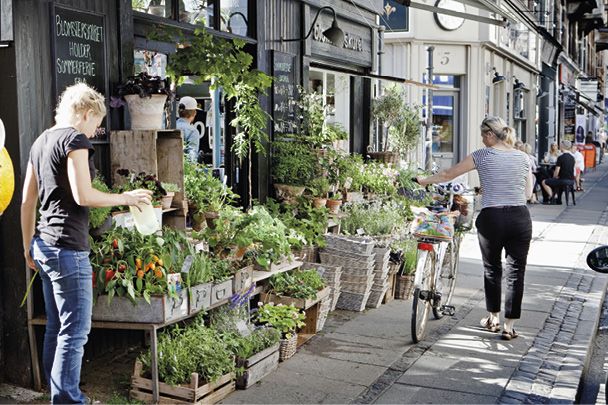
![]() 41 20 63 13,
41 20 63 13, ![]() natmus.dk/museerne/musikmuseet. Tues–Sun 10am–5pm. 50kr.
natmus.dk/museerne/musikmuseet. Tues–Sun 10am–5pm. 50kr. ![]() 33 12 12 24,
33 12 12 24, ![]() planetariet.dk. Mon noon–7.40pm, Tues–Thurs & Sun 9.30am–7.30pm, Fri & Sat 10.30am–8.45pm. Adults/children under 12 150kr/99kr including IMAX film, 89kr/64kr without.
planetariet.dk. Mon noon–7.40pm, Tues–Thurs & Sun 9.30am–7.30pm, Fri & Sat 10.30am–8.45pm. Adults/children under 12 150kr/99kr including IMAX film, 89kr/64kr without. 
![]() 33 27 12 82,
33 27 12 82, ![]() visitcarlsberg.dk. Daily 10am–5pm. 85kr.
visitcarlsberg.dk. Daily 10am–5pm. 85kr. ![]() dansehallerne.dk), a modern-dance performance venue at Tap E (scheduled to move out 2016) and, in the old garages, Galleri Nicolai Wallner (
dansehallerne.dk), a modern-dance performance venue at Tap E (scheduled to move out 2016) and, in the old garages, Galleri Nicolai Wallner (![]() nicolaiwallner.com), the city’s largest private gallery for contemporary art. You could easily spend a half-day exploring the complex. Landmark sights include the iconic Elephant Gate, the glorious winding Lotus Chimney, the Lime Tower lighthouse and the Star Gate – the original main entrance to the brewery. Many of Carlsberg’s luscious green spaces have also been opened up to the public, including J.C. Jacobsen’s delightfully tranquil garden, which was first laid out in 1848.
nicolaiwallner.com), the city’s largest private gallery for contemporary art. You could easily spend a half-day exploring the complex. Landmark sights include the iconic Elephant Gate, the glorious winding Lotus Chimney, the Lime Tower lighthouse and the Star Gate – the original main entrance to the brewery. Many of Carlsberg’s luscious green spaces have also been opened up to the public, including J.C. Jacobsen’s delightfully tranquil garden, which was first laid out in 1848.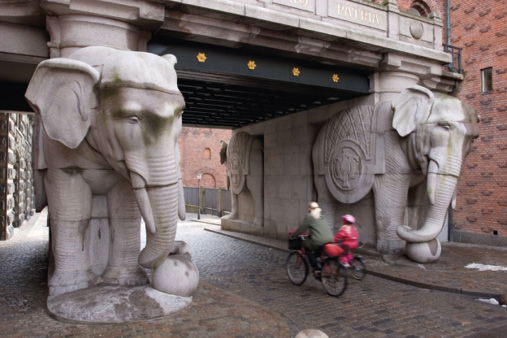
![]() ses.dk. Gardens: 6am–sunset; free. Palace: guided tours Jan–June & Aug–Nov last Sat of the month 11am & 1pm; 50kr.
ses.dk. Gardens: 6am–sunset; free. Palace: guided tours Jan–June & Aug–Nov last Sat of the month 11am & 1pm; 50kr. ![]() 72 20 02 00,
72 20 02 00, ![]() zoo.dk. Open from 10am; closing times vary (check website). 180kr, children under 12 100kr.
zoo.dk. Open from 10am; closing times vary (check website). 180kr, children under 12 100kr. 